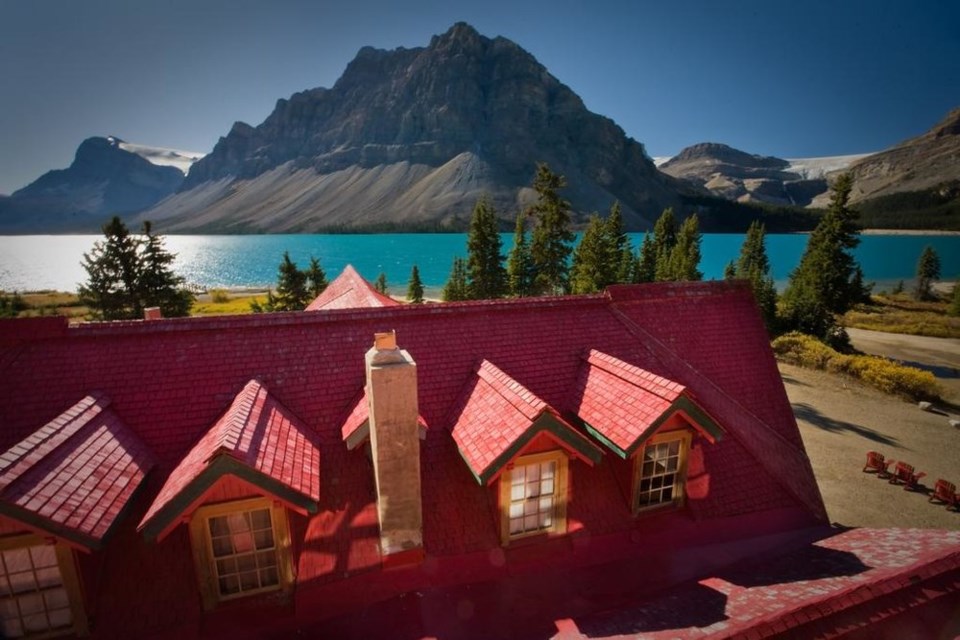LAKE LOUISE – The new owners of a historic lodge on the shores of Bow Lake are planning a redevelopment of the site at the headwaters of the Bow River.
The iconic red-roofed Lodge at Bow Lake, formerly known as Num-Ti-Jah Lodge, on Highway 93 North, welcomed guests until 2020 when the COVID-19 pandemic shut down operations, but a refurbished and renovated lodge, which had been in a state of disrepair for years, reopened last summer.
The proposal includes additional overnight guest accommodations, including cabins, a hot pool, staff housing and a café/gallery at the site which is historically linked to mountaineer, trapper, guide and Scottish-runaway Jimmy Simpson.
Bruce Miller, one of the new owners of the Lodge at Bow Lake and a former owner and operator of Lake O’Hara Lodge in neighbouring Yoho National Park, said he believes he has a solid track record as a steward of national parks.
“We will continue with that same philosophy here,” he said.
The total number of guest accommodation units being proposed is 35, with a guest capacity of 72. This remains within the 2007 Parks Canada outlying commercial accommodation (OCA) site-specific guidelines, which indicate a maximum of 36 guest units and an occupancy limit of 108 guests.
The proposal includes construction of an 18-unit guest accommodation building northwest of the existing main lodge on already disturbed land.
A café and gallery would also be constructed in an area to the northeast of the main lodge to serve the roughly 3,000 daily visitors each summer.
Although hot springs do not exist in the area, a hot pool created in the theme of those in the Japanese Alps will be constructed on-site.
In the future, the owners are also proposing to build a number of small cabins.
New staff accommodation has also been built.
Miller said the goal is to take advantage of the extensive presently disturbed ground and construct any new buildings in these areas while minimizing any construction in forested areas.
He said the proposed work also presents an opportunity to reclaim some of the previously disturbed ground using native soils and plantings.
“There is so much gravel and everything around and our intention is to rehabilitate it so that we become a smaller footprint, so to speak, on the landscape as a result,” said Miller.
Bow Valley Naturalists say they are concerned about the continuing expansion of commercial facilities in national parks.
“As with the rejected gondola and proposals for parking lot expansions onto natural habitats in Banff townsite, this proposal is an example of the tourism industry’s commitment to ongoing cumulative growth in visitation and expansion of human activity, with associated infrastructure, in protected ecosystems,” said Peter Duck, the group’s president.
“The Bow Lake shoreline and wetland ecosite is one more location under threat in Banff National Park and we hope Parks Canada will respect its legal mandate, not just to maintain, but to restore the integrity of the natural resources and processes at this unique location.”
Parks Canada is now considering public input on the draft detailed impact assessment, which closed May 31, before sending the development proposal to the park superintendent for approval.
Jón Stuart-Smith, Parks Canada’s manager of land use policy and planning for Lake Louise, Yoho and Kootenay field unit, said the proposal must meet the 2007 OCA guidelines.
“This proposal that we’ve received fits within those parameters that were outlined in the OCA guidelines,” he said. “We would not consider anything that goes above those limits, but I don’t believe the current proposal suggests that.”
The results of the detailed impact assessment identified the loss of riparian habitat – within 30 metres of a waterbody – as one adverse impact despite the implementation of mitigation measures as the planned 18-unit lodge would partially encroach on the riparian zone.
Stuart-Smith said there are species now under the Species at Risk Act, such as bull trout, since the 2007 OCA guidelines were established.
“What we’re trying to balance is what was outlined in the OCA guidelines with what we know now in terms of that habitat,” he said.
“If there’s already a disturbed area within that 30-metre riparian area, rather than create a newly disturbed area, we would consider proposals to build within disturbed areas that may be within that 30m guideline.”
The owners also have proposed some smaller cabins in future, which would require a lease boundary change.
Miller said the cabins are a future goal.
“That requires some additional discussions with Parks Canada,” he said.
Stuart-Smith said reconfiguring the boundary of the lease is not a simple process, but the agency is prepared to look at it if it means removing some more sensitive habitat for bull trout from the lease.
“It would be part of the management planning process, but it is something that we are considering if we are able to make substantive environmental gains by returning the critical habitat to the park,” he said.
The owners intend to open the facility on a seasonal basis, operating about nine months of the year from May to October and January to April.





